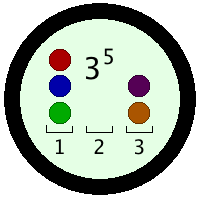Overview:
Working alone or in a group of two, you will research a combinatorial question and present your findings through a poster. The goals of this project are to apply the techniques we learn this semester to counting questions that arise in the real world and to experience a taste of mathematical research.
If you work in a group of two, then you will have two posters, and each group member is responsible for both posters. (Two people = twice as much work.)
Choosing a project topic:
Brainstorm one or more topics that relate to your interests outside school or work. What do you enjoy doing? What motivates you? What do you love learning about? What is something you always have on your mind? Use these questions to help you choose a general topic area.
Next, think about what you might be able to count or describe discretely in these areas. Come up with a precise problem statement by the due date. [Precisely, what are you counting?] An important part about your project is that it must involve some original research.
By the due date, send me an email with the precise problem statement you want to investigate. If you have multiple ideas, let me know and I can help to refine their scope. You will have a chance to revise your project topic in the week following submission. If you would like more guidance, feel free to stop by during office hours to chat.
Deliverables:
On the scheduled poster session date, you will be required to submit a poster, as described below. After the poster session, we will schedule an interview to share your work with a wider audience by way of a joint podcast.
Poster Specifications:
Your poster has two purposes. It serves as a stand-alone record of the work you have done on your project. It also serves as a visual aide that helps you in your presentation to convey to your audience what you learned.
For the former purpose, you should digest the research you did over the semester and determine the most relevant parts of it. Do not show scratch work or large calculations but summarize the work that you did. Include information about the techniques that you used so that other people would be able to recover your results given enough time. All words necessary to understand your subject should be ON the poster. You should expect that your audience has taken our class and has some background in combinatorics. (No need to explain what a generating function is!)
For the latter purpose, you need to make sure that your work is presented in a logical and creative manner. During the poster session, you will have 5–8 minutes to present your work to your classmates and to the instructor. You will explain your work, including your project statement and your conclusions. Of more interest to your audience will be the background of your project, the processes you used, and what you found the most interesting during your research. It is also nice to share a question for future work. You should practice this short "elevator pitch" and it may inform you of the best way to organize the material on your poster.
Be creative! Color is encouraged! Draw the focus of the audience with nice visualizations. Do not try to fit too much information onto the poster; think about what is the key information that needs to be conveyed.
Each poster should be approximately the size of two pieces of posterboard (each 22'' by 28'') which is also about the size of a large tri-fold poster, for a total of approximately 8 square feet. (Remember that for a group of two, you will need twice this area!) You may write on the posterboard or glue printed documents to the posterboard. The smallest font you use should be no less than size 20.
Podcast Specifications:
I will record a brief interview with you about your project to highlight the questions you are asking and the answers you find to give your work wider visibility. In lieu of a final exam, we will schedule a 20-minute interview session where I will ask you a fixed set of questions. These questions will be finalized by the last week of class, and you are welcome to (and gently suggested to) prepare written responses to these questions before our interview session. I would like to share these interviews with a greater audience, but rest assured that I will never publish anything publically without your permission.
Preliminary Question List:
- What is your name?
- Tell me more about yourself.
- What topic did you decide to research, and why?
- What answer did you find?
- What are the key techniques you used?
- What was the most interesting thing about your research?
- What is a related question you would have liked to study if you had had more time?
Deadlines:
- Poster topic due: Wednesday, October 23.
- Revised topic due: Friday, November 1. (If applicable.)
- Poster due and poster presentations: Wednesday, December 11.
- Podcast recording sessions: Scheduled individually, December 12–17.
Grading:
This project represents 30% of your grade for the semester. You will be graded on each of the following standards.
- Timeliness and Style:
- Have you met with satisfaction the deadlines associated to the project?
- Did you make continual progress throughout the project window?
- Did you follow the writing format requirements?
- Do you use complete sentences and proper English?
- Thoughtfulness of Research:
- Does the subject level of your project match your level of expertise in the subject?
- Does the project show advancement in your understanding of combinatorics?
- Research Quality: (*)
- Did you explore your project topic in depth?
- Do you use combinatorial methods to solve your question?
- Is the content complete and able to stand alone?
- Is the content mathematically rigorous?
- Poster Clarity:
- Is the poster easy to read and follow logically?
- Is the spacing of the material pleasant?
- Are the key ideas highlighted and easy to process?
- Is your problem statement clearly conveyed?
- Presentation:
- Can you explain to your classmates and to the instructor in a short time the highlights of your research by using your poster as a visual aide?
- Is it obvious that you were organized and had practiced for the presentation?
- Did you arrive on time for everyone else's presentation?
- Podcast:
- Are you able to summarize the key ideas of your research orally in a clear and coherent manner?
- Do you have an interesting question for future study?
You will be assigned a score for each standard from the following scale.
Your final project grade will be based on the number of scores at each level as follows.
4 Outstanding: Goes above and beyond expectations 3 Excellent: Meets all requirements at a high level. 2 Good: Meets all requirements at an competent level. 1 Poor: Makes an effort to meet requirements but does not succeed. 0 Unacceptable: No work, a weak start, or does not meet minimum acceptable standards.
A+ (100+) Earn a score of 4 on at least three standards and no score lower than 3. A (95) Earn a score of 3 or more on at least four standards (including Research Quality) and no score lower than 2. B (85) Earn a score of 2 or more on at least five standards (including Research Quality) and no score lower than 1. C (75) Earn a score of 2 or more on at least three standards (including Research Quality) and no score lower than 1. D (65) Earn a score of 1 or more on at least five standards (including Research Quality). F (0-50) Earn a score of 0 on two or more standards.
Examples:
What does a finished poster look like? Here are some examples to whet your appetite. These are here to give you an idea of poster presentation; you should come up with your own idea for the project topic.


